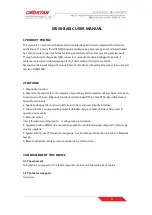
4.7.4 Filter Envelope
An envelope controls a sound parameter over time,
starting from the instant a key is pressed (see fig. 4.7).
The filter envelope is designed specifically to control
the filter cutoff frequency, but can be used to control
other parameters too via the modulation matrix.
Attack
Decay
Release
Time
Level
Key pressed
Key released
Sustain
Figure 4.7: The filter envelope.
Amount
The AMT knob controls how much the filter envelope
affects the cutoff frequency. Set to zero, the filter en-
velope has no effect on the cutoff frequency. At 100%,
the envelope spans the entire cutoff range from the
minimum to the maximum value. Most sounds will
use a low-pass filter with an envelope amount setting
in between the two extremes and the envelope attack
and sustain set to their minimum values. This cre-
ates the most common timbre which is a bright start
followed by a darker sustain stage, a property shared
by many acoustic instruments. Note that when a dual
filter is used, the filter envelope affects both filters si-
multaneously.
In rare cases, you may also want to set the envelope
amount to a negative value. This can be helpful to
create sounds which become bright when releasing a
key. A negative envelope amount can be set using the
modulation matrix, with the envelope amount knob
set to zero.
Attack
The ATTACK parameter specifies the duration it
takes for the envelope to reach its maximum value.
Most sounds use a setting near the minimum in order
to start bright.
Decay
After reaching the peak, the decay stage commences.
During the decay stage, the envelope falls back to a
lower level, the sustain level.
The DECAY control
36
DUNE 2 User’s Manual
Summary of Contents for DUNE 2
Page 1: ...User s Manual...
















































